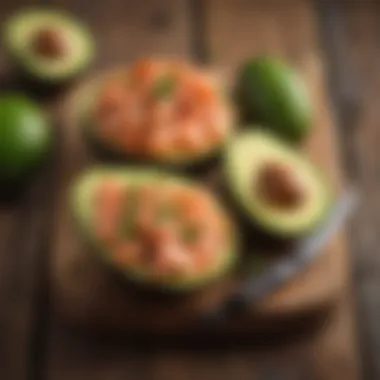Delicious High Fat Low Carb Dinner Ideas


Intro
The rise of high fat, low carbohydrate diets has led many culinary enthusiasts to seek options for satisfying dinner recipes that align with these dietary principles. Understanding how to create meals that are rich in healthy fats while keeping carbohydrates low can be both practical and enjoyable. This article takes a closer look at the essential components of these dishes, offering a comprehensive guide to making high fat, low carb dinners that cater not just to the nutritional preferences but also to fulfilling taste and texture desires.
With today’s busy lifestyles, meal preparation can often feel like a chore. However, the right knowledge and strategies can transform cooking into a rewarding experience. This article will explore creative recipes, essential ingredients, and practical cooking tips that support your dietary goals. From easy preparation techniques to comprehensive nutritional insights, each section aims to empower readers with the skills to craft delicious yet simple meals.
Recipe Overview
Creamy Garlic Butter Chicken
- Portions: 4 servings
- Prep Time: 10 minutes
- Cook Time: 20 minutes
- Difficulty: Easy
- Main Ingredients:
- Chicken breasts
- Heavy cream
- Garlic
- Butter
- Parmesan cheese
- Spinach
This recipe offers a wholesome option for those adhering to a high fat, low carb lifestyle. The combination of ingredients provides a rich, creamy flavor while maintaining low carbohydrate content. Each bite delivers both satisfaction and essential nutrients crucial for energy and well-being.
Step-by-Step Instructions
- Prepare the Ingredients:
- Cooking the Chicken:
- Making the Sauce:
- Combine Ingredients:
- Serve:
- Cut chicken breasts into smaller pieces.
- Mince several cloves of garlic.
- Measure out heavy cream and grated parmesan cheese.
- Have fresh spinach ready, rinsed and chopped if necessary.
- In a large skillet, melt butter over medium heat.
- Add the chicken pieces and cook until browned, around 5-7 minutes.
- Remove chicken and set aside.
- In the same skillet, add minced garlic and sauté for 1-2 minutes until fragrant.
- Lower the heat before pouring in heavy cream. Stir well to combine.
- Add parmesan cheese and continue mixing until it has melted into the sauce.
- Return the chicken back to the skillet, instructing it to absorb the flavors of the sauce.
- Toss in fresh spinach and cook until wilted, about 2-3 minutes.
- Plate your dish and sprinkle additional parmesan on top if desired.
Time-Saving Strategies:
- Consider preparing chicken ahead of time and marinating it overnight for added flavor.
- Using frozen spinach can save washing and cutting time. This substitution maintains the nutritional profile without sacrificing taste.
Nutritional Information
- Calories per portion: 480
- Protein: 40g
- Fats: 35g
- Carbohydrates: 5g
This creamy garlic butter chicken is packed with beneficial nutrients. It is especially high in protein, vital for muscle repair and growth, while also boasting a significant amount of healthy fats derived from the butter and cream, aiding in nutrient absorption and hormonal balance.
Quick Cooking Tips
- Utilize kitchen gadgets: An air fryer can achieve a crisp chicken texture while reducing cooking time significantly.
- Multitasking: While preparing chicken, chop garlic and measure out ingredients simultaneously. This approach minimizes delays in the cooking process.
Related Recipes & Variations
- Zucchini Noodles with Pesto: A perfect side dish filled with healthy fats from olive oil and pine nuts, it complements the creamy chicken well.
- Cauliflower Rice: A low-carb alternative to traditional rice, providing a fluffy texture that pairs excellently with sauces.
There are many ways to modify this dish. For a lower calorie option, reduce cream and increase the amount of spinach for fiber. Alternatively, substitute chicken for shrimp to vary the flavor profile. Preparing meals like encourages exploration and innovation in the realm of high fat, low carb cooking.
Meal prep can also be simplified by batch cooking your proteins or vegetables, making weeknight dinners a easier task.
Understanding High Fat Low Carb Diets
The topic of high fat low carb diets represents a significant shift in dietary philosophy. These diets prioritize fats and limit the intake of carbohydrates, fundamentally altering macronutrient intake. Understanding these diets means recognizing their mechanisms, potential benefits, and the ways they can enhance culinary experiences while aligning with nutritional goals.
Definition and Overview
High fat low carb diets, often referred to as ketogenic or keto diets, are structured primarily around high-intake of fats and minimal consumption of carbohydrates. This approach pushes the body into a state of ketosis, where it burns fat for fuel instead of glucose. Research has shown that such diets can lead to various metabolic changes, supporting weight loss and improved body composition. Common characteristics of these diets include a focus on healthy fats like avocados, olives, and fatty fish, while drastically cutting down on grains and sugars.


Historical Context
The origins of high fat low carb diets trace back to the early 20th century, originally developed as therapeutic diets for epilepsy. Over the decades, their application has expanded, gaining popularity among those seeking weight management and improved health metrics. In the 1970s, Dr. Robert Atkins popularized the Atkins diet, which laid the foundation for modern low carb diets. This evolution shows how dietary trends can shift based on emerging research and societal needs, making them relevant today.
Health Benefits
The benefits of high fat low carb diets are numerous and can vary by individual. Some of the most commonly noted advantages include:
- Weight Loss: Many individuals find it easier to lose weight as the body adapts to burning fat for energy.
- Improved Blood Sugar Control: Lower carbohydrate intake can stabilize blood sugar levels, which is particularly beneficial for those with insulin resistance or diabetes.
- Enhanced Mental Clarity: Some report increased focus and energy as they adapt to ketosis.
- Reduced Hunger: High-fat meals tend to provide satiety, reducing the tendency to snack frequently.
From a health perspective, understanding these benefits can help individuals make informed choices about their diet, emphasizing not only taste but also nutrition.
Key Ingredients for High Fat Low Carb Dinners
When it comes to high fat low carb dinners, selecting the right ingredients is paramount. These ingredients not only affect the nutritional profile of meals but also influence flavor, texture, and overall satisfaction. A well-planned inventory of key ingredients can facilitate the creation of diverse and enticing meals. Understanding the specifics of protein, fat, and low-carb vegetables equips one with the necessary tools to craft meals that align with dietary preferences without sacrificing taste.
Proteins: Choosing Wisely
Proteins play a crucial role in a high fat low carb diet. They serve not only as the cornerstone of meals but also help to maintain muscle mass during weight loss or dietary changes. Choosing high-quality protein sources can impact satiety levels. While there are many options, it is essential to consider both the quality and the fat content. Options like grass-fed beef, wild-caught fish, and organic poultry offer higher nutrients and lower inflammation potential. Additionally, eggs are a versatile staple that provides rich nutrition.
It's important to be mindful of processed protein sources. Many store-bought options contain hidden sugars and carbs that can undermine dietary goals. Lean meats such as turkey and chicken breast fit well in a low carb regime but prioritize fatty cuts when aiming for high fat content. Established protein-rich meals can be creative and appealing, ensuring adherence to dietary plans while being enjoyable.
Fats: The Healthy Options
Fats are integral to a high fat low carb diet. They act as the primary energy source in this eating plan. When selecting fats, not all types are equivalent. Healthy fats promote overall wellness while also enhancing flavors in dishes. Options such as avocados, olive oil, coconut oil, and nuts provide essential fatty acids and vitamins.
Including omega-3 fatty acids is beneficial for maintaining cognitive health and reducing inflammation. Sources like fatty fish and flaxseeds are excellent options. It's also vital to avoid trans fats and excessive amounts of saturated fats found in processed foods. Instead, focus on incorporating a variety of healthy fats into meals for richness and health promotional properties.
"Quality fats are a fundamental aspect of a sustainable low-carb diet, providing energy and essential nutrients."
Low Carb Vegetables
Low carb vegetables add necessary fiber, vitamins, and minerals to a high fat low carb dinner. They also contribute to the overall volume of meals without significantly increasing carbohydrate intake. Vegetables such as spinach, kale, broccoli, cauliflower, and zucchini are excellent choices. They can be prepared in numerous ways ranging from sautéing to roasting.
These vegetables often serve as base ingredients which can substitute higher-carb alternatives. For instance, zucchini can replace pasta, and cauliflower can act as a rice substitute. This creative swapping can keep meals varied and interesting. Selecting seasonal vegetables ensures freshness and often better flavor, making the overall dining experience more enjoyable.
Integrating these vitamin-rich, low carb options diversifies meals and can prevent dietary monotony. Ultimately, understanding and utilizing these ingredients is crucial for anyone interested in high fat low carb dining.
Preparing High Fat Low Carb Dinners
Preparing high fat low carb dinners is crucial for individuals following this dietary approach. This section will address the significance of thoughtful meal preparation and the necessary strategies to achieve success. A well-planned dinner not only aligns with nutritional goals but also saves time and reduces stress during busy weekdays. By implementing effective meal planning, batch cooking, and utilizing kitchen gadgets, one can create satisfying, health-conscious meals.
Meal Planning Strategies
Effective meal planning is the cornerstone of a successful high fat low carb lifestyle. It ensures you have the right ingredients on hand and reduces the temptation to revert to processed, high-carb options. Here are some strategies to enhance your meal planning:
- Set a Weekly Menu: Dedicate time each week to plan your meals. This can be a simple list of dinners that focus on variety while remaining within your dietary framework.
- Create Shopping Lists: After planning, generate a comprehensive shopping list based on your menu. This minimizes impulse purchases and ensures you have all necessary ingredients.
- Incorporate Leftovers: Plan meals that can produce leftovers for convenient lunches or dinners later in the week, ensuring food does not go to waste.
- Balance Your Meals: While high fat and low carb are key elements, ensure nutritional diversity by including various proteins, healthy fats, and low-carb vegetables in each meal.
Batch Cooking Techniques
Batch cooking can drastically reduce the amount of time spent in the kitchen daily. By preparing multiple servings at once, you can simplify weeknight dinners. Consider these techniques for effective batch cooking:
- Cook in Batches: Choose recipes that can be doubled or tripled. Meals like keto chili or creamy mushroom soup hold well in the refrigerator or freezer.
- Portion Control: As you cook, portion out meals into containers. This makes reheating easy and prevents overeating.
- Freeze Wisely: Not all meals freeze well. Focus on recipes that maintain their texture and flavor after freezing.
- Label Containers: Proper labeling with dates and meal names helps track what you have available and when to consume it.
Using Kitchen Gadgets Efficiently
Maximizing the use of kitchen gadgets can streamline the preparation of high fat low carb dinners. Efficient use of technology reduces cooking time and enhances meal quality. Here are some suggestions:
- Slow Cooker: Great for soups, stews, or braised dishes, allowing you to set it and forget it while you focus on other tasks.
- Instant Pot: This versatile appliance can pressure cook meats and veggies quickly, preserving nutrients and flavors.
- Blender: Useful for sauces, smoothies, or pureeing vegetables, ensuring dietary needs are met without added carbs.
- Food Processor: Simplifies chopping, shredding, or mixing, making ingredient prep more efficient, especially for salads or vegetable dishes.


Planning and preparation are key components that enable adherence to a high fat low carb diet, making it sustainable and enjoyable.
By implementing these strategies, individuals can more easily navigate the challenges that come with preparing high fat low carb dinners. With thoughtful planning, effective batch cooking, and the right gadgets, the culinary journey aligns with dietary goals, ensuring satisfying meals without compromise.
Quick and Easy High Fat Low Carb Recipes
The importance of quick and easy high fat low carb recipes cannot be overstated. In a fast-paced world, many individuals seek solutions that simplify meal preparation while adhering to their dietary preferences. These recipes are not only simple but also designed to maximize flavor and satisfaction, making them perfect for anyone looking to maintain a healthy diet without sacrificing taste. By focusing on quick meals, we empower those who have limited time to enjoy nutritious high fat, low carb options.
Savory Dinner Ideas
Creamy Garlic Butter Chicken
Creamy Garlic Butter Chicken combines tender chicken pieces with a rich, buttery sauce. It stands out for its ability to deliver a satisfying flavor profile while remaining low in carbohydrates. This dish is a beneficial choice because it aligns perfectly with high fat low carb standards. The rich garlic flavor not only enhances the dish but also provides health benefits attributed to garlic.
The unique feature of Creamy Garlic Butter Chicken is its creamy texture achieved through the addition of heavy cream and butter. However, one should be mindful of portion sizes, as the dish can be calorie-dense.
Zucchini Noodles with Pesto
Zucchini Noodles with Pesto is a fantastic alternative to traditional pasta. This dish focuses on using zucchini as a base, making it low in carbohydrates while still providing a fulfilling meal. The key characteristic here is the fresh basil pesto, which adds a vibrant flavor to the dish. This makes it a popular choice for those seeking to avoid grains.
A unique feature of this meal is its versatility; it can be made with various pesto types or even homemade sauces. The main disadvantage is that zucchini can release moisture, making it less ideal for those who prefer a firmer noodle structure.
Beef Stir-Fry with Broccoli
Beef Stir-Fry with Broccoli is a classic that takes advantage of quick cooking methods to save time. This recipe is significant for its rich protein content and the inclusion of nutritious vegetables. The key aspect of this dish lies in its balance of fats and proteins, supporting a low-carb lifestyle.
The unique feature of this stir fry is its rapid preparation. Just a few minutes in a hot skillet ensures tender meat and crisp vegetables. However, it is important to manage seasoning to avoid hidden sugars often found in sauces.
One-Pan Meals
Sheet Pan Salmon with Asparagus
Sheet Pan Salmon with Asparagus is a meal that maximizes flavor through simplicity. The dish features salmon, which is high in healthy fats alongside asparagus, a low-carb vegetable. Its importance lies in the ease of preparation and clean-up, making it ideal for busy weeknights.
The key characteristic of this dish is how the natural flavor of salmon shines when roasted with asparagus. Its unique feature is the blend of spices that can be adjusted to personal taste. However, care should be taken not to overcook the salmon, as it can become dry.
Skillet Cauliflower Fried Rice
Skillet Cauliflower Fried Rice effectively substitutes high-carb rice with cauliflower, maintaining the comfort of fried rice without excess carbs. The dish’s contribution is profound, delivering flavor and texture without the heaviness of traditional fried rice.
A significant aspect is its quick cooking time, allowing for a flavorful meal in under 15 minutes. A unique feature is its adaptability; one can include various proteins or vegetables. The downside may be the texture may not fully replicate that of real rice for some individuals.
Mediterranean Chicken Bake
Mediterranean Chicken Bake incorporates vibrant Mediterranean flavors into a one-pan dish. This meal is beneficial because it combines protein, healthy fats, and low-carb vegetables into one easy preparation. The key characteristic is the use of olives and feta cheese, enriching the flavor profile.
The unique feature lies in its presentation; the colorful ingredients create a visually appealing dinner. However, the drawback is that it requires careful seasoning to ensure the dish is not overly salty.
Soups and Stews
Keto Chili
Keto Chili focuses on high-fat ingredients while keeping carbs to a minimum. It often replaces beans with vegetables, maintaining a hearty texture. This dish is critical for providing a warming meal that also aligns with keto diet principles.
Its key characteristic is the robust flavor from spices, which makes it satisfying. A unique feature is the option to customize spice levels and toppings. However, some might miss the traditional bean texture in chili.
Creamy Mushroom Soup
Creamy Mushroom Soup serves as a rich option ideal for low-carb eating. The dish is made from fresh mushrooms, cream, and spices, providing a comforting experience. Its importance lies in its ability to satisfy hunger without substantial carbs.


The key characteristic is its creamy consistency, elevated by the addition of spices like thyme. A unique feature is the choice to include various mushrooms for added depths of flavor. The downside may be the need for fresh ingredients to achieve optimal taste.
Chicken Cacciatore
Chicken Cacciatore combines chicken with tomatoes and herbs, resulting in a hearty dish. It provides a balance of flavors and can be adapted to omit high-carb elements. The key characteristic is the way the chicken absorbs the flavor from the sauce, enhancing the overall dish.
A unique feature is its ability to be served on its own or with keto-friendly bread. However, attention should be paid to the tomato content, as added sugars can sometimes occur in canned versions.
Addressing Common Challenges
As individuals explore high fat, low carb dining, they may encounter a few challenges that can hinder their culinary experience. Addressing these challenges is crucial to enjoying meals while adhering to dietary goals. It not only supports individuals in navigating the complexities of meal preparation but also enhances overall meal satisfaction. This section discusses the critical aspects of ingredient availability, meal prep time management, and the balance between taste and nutrition, empowering readers with insights for better cooking practices.
Overcoming Ingredient Availability Issues
Finding specific ingredients suited for high fat, low carb dinners can sometimes feel daunting, especially if one lives in an area with limited grocery options. To overcome these obstacles, knowing what to look for can be beneficial. Consider exploring local farmers' markets, which often stock fresh vegetables and meats that fit into this diet. Seasonal produce can provide a variety of flavors that enhance meals while sticking with low carbohydrate guidelines.
Additionally, online grocery stores can be a valuable resource. Products like coconut oil, almond flour, and various dietary supplements can typically be ordered with ease. One can also try to adapt recipes based on what is readily available. For instance, if zucchini is out of season, using spaghetti squash instead can maintain low carb integrity without compromising on taste.
Managing Meal Prep Time
Time management is often a significant concern for those who want to incorporate high fat, low carb meals. Effective meal prep can minimize daily cooking time, making healthy eating more convenient. A strategic plan is essential for success in meal preparation.
- Choose a specific day for meal prep: Identifying a time in advance, often on weekends, allows one to batch cook meals for the week ahead.
- Utilize versatile ingredients: Ingredients that can be cooked and incorporated in multiple dishes, such as chicken thighs or cauliflower, can save time and provide options.
- Invest in good kitchen gadgets: Appliances such as slow cookers, Instant Pots, or air fryers can significantly reduce cooking times and improve the ease of preparation.
By embracing a systematic approach, individuals can foster a more efficient cooking environment that supports high-fiber meals without excessive time commitment.
Balancing Taste and Nutrition
One common misconception about high fat, low carb diets is that meals lack flavor. However, achieving a balance between taste and nutrition is very possible. Focusing on variety within recipes can ensure meals are both enjoyable and nourishing. Here are some strategies to consider:
- Season generously: Using herbs, spices, and healthy sauces can heighten flavors without increasing carbs.
- Experiment with cooking methods: Grilling, sautéing, or roasting can enhance the natural taste of proteins and vegetables.
- Incorporate new recipes: Encourage creativity by trying dishes from various cuisines that fit the dietary framework.
"A well-balanced plate can be achieved with the right approach to seasoning, cooking methods, and recipe variety."
Ultimately, by actively focusing on overcoming ingredient availability issues, managing meal prep time effectively, and balancing taste with nutrition, individuals can fully embrace the joys of high fat, low carb dining. This proactive mindset will facilitate a more positive relationship with food and dietary choices.
Final Considerations for High Fat Low Carb Dining
When engaging in high fat, low carb dining, it's important to consider the broader implications of this dietary approach. Health choices are often subjective and can vary widely among individuals. This section aims to provide substantial insights into maintaining satisfaction and nutritional needs through three pivotal aspects: integrating variety, listening to bodily signals, and sustaining dietary changes over time.
Integrating Variety into Meals
Maintaining a diverse diet is crucial for preventing monotony and ensuring a balanced intake of nutrients. High fat, low carb diets can sometimes fall into repetitive patterns. Thus, creativity in meal prep becomes vital. Here are some ways to incorporate variety into your meals:
- Explore different cuisines: Delve into Mediterranean or Asian flavors. Incorporate dishes like Greek salads with feta cheese or Thai coconut curry made with coconut milk.
- Experiment with cooking methods: Alternate between grilling, baking, and sautéing to bring out new flavors and textures.
- Use seasonal ingredients: Focus on fresh produce that is available throughout the year. This keeps meals aligned with seasonal eating, enhancing flavor and nutrient density.
By ensuring variety, you keep the palate excited while also getting a broader range of nutrients, which is essential for overall health.
Listening to Your Body's Responses
One fundamental aspect of any diet is tuning into how your body reacts to certain foods. High fat, low carb diets may bring changes to energy levels, digestion, and overall well-being. Paying attention to these signals can inform future dietary decisions.
- Energy Levels: Some might experience a new-found energy and clarity of mind, while others may struggle initially. It's essential to recognize these shifts.
- Digestion: Introducing higher fat foods requires time for your body to adjust. Notice if any particular food causes discomfort.
- Mood and Satiety: Assess if meals are satisfying and how they affect your mood. This influences not just physical, but emotional, health as well.
Recognizing and respecting the body's feedback can facilitate a more intuitive approach to dieting, ensuring that choices are tailored to personal needs.
Sustaining Long-Term Dietary Changes
Commitment to dietary changes poses its own challenges. It is not just about making a choice for today; it is about sustaining it over time. Here are some tips that may assist with this process:
- Set Realistic Goals: Aiming for gradual changes rather than an overnight transformation can lead to better adherence.
- Seek Support: Engage with communities, either online or in person. Forums like Reddit or Facebook groups can provide motivation and share successful tips.
- Reflect on Progress: Maintain a journal of meals, emotions, and outcomes. This reflection can highlight successful practices and areas needing adjustment.
By taking a thoughtful approach to long-term changes, individuals can establish healthier habits, supporting both physical and emotional well-being.
In summary, the success of a high fat, low carb diet relies heavily on variety, self-awareness, and sustainable practices. By focusing on these elements, individuals can enhance their dining experience while maintaining alignment with their dietary objectives.







